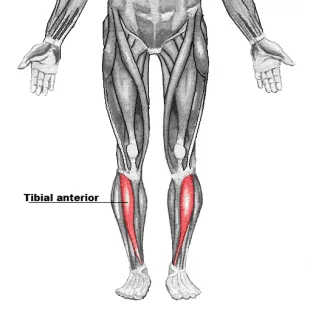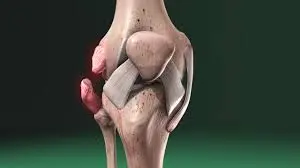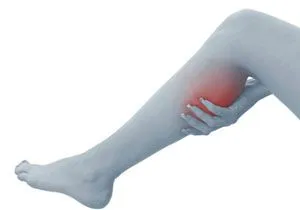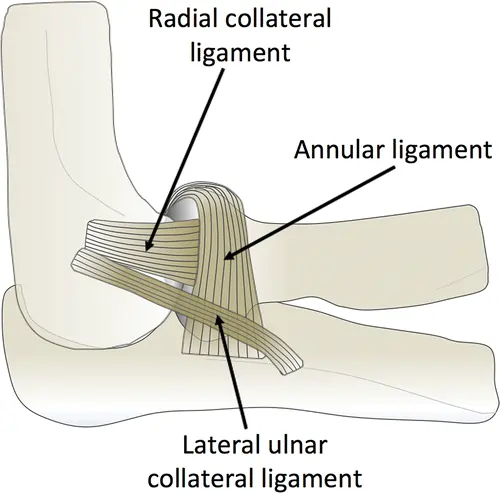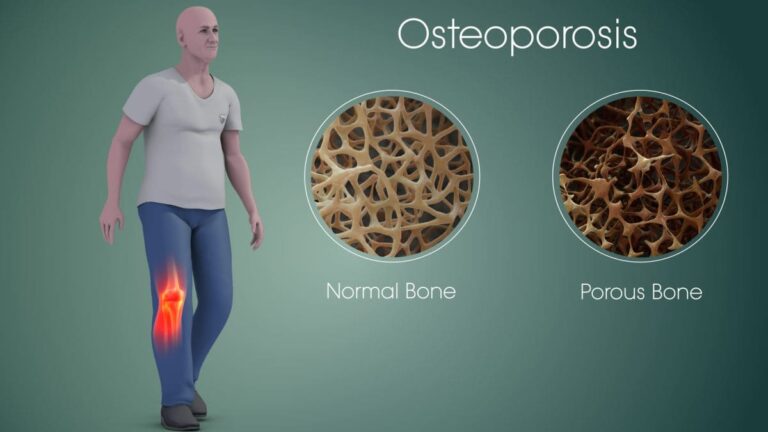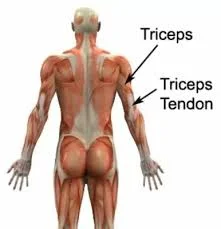Tibialis Anterior Muscle Pain
Tibialis anterior muscle pain refers to discomfort or soreness in the muscle located along the front of the lower leg. This muscle is essential for dorsiflexion, which involves lifting the foot upward, and plays a vital role in stabilizing the ankle during movement.
Pain in this area is often associated with overuse, strain, or repetitive activities such as running, walking on uneven terrain, or sports that involve frequent changes in direction.
What is the Tibialis Anterior Muscle Pain?
- The muscle that is locked at the front of the lower leg and connected to the top of the foot is the source of this tibialis anterior muscle pain.
- The pain the patient experiences here is mistaken for shin splints, which cause pain on the inside of the shin and lower leg.
- The tendon on the top of the foot and the front of the lower leg, which is outside the tibia bone, are the sites of this pain.
- The big tendon that is visible spanning the front of the ankle joint is this muscle tendon.
Anatomy of the Tibialis Anterior Muscle?
- In the leg, this tibialis anterior crosses over into the deep peroneal nerve and anterior tibial vessels.
- The lateral condyle and the upper half/two-thirds of the lateral surface of the tibia’s body are the origins of the tibialis anterior muscle.
- between it and the Extensor Digitorum Longus is the intermuscular septum.
- the fascia’s deep surface.
- The medial and undersurface of the first cuneiform bone as well as the base of the first metatarsal bone are where the tibialis anterior muscle is implanted.
- Pulling the foot up, which involves ankle joint flexion and dorsiflexion, is one of the primary roles of the tibialis anterior muscle.
Causes of Tibialis Anterior Muscle Pain?
- Pain in the tibialis anterior muscle is caused by overuse and injury to the muscle.
- Because the anterior tibialis muscle helps to maintain the medial arch, a collapse of the arch results in overwork of the muscle, which causes an inner arch with an inward tilt of the ankle.
- It is extremely uncommon for an abrupt injury to result in a tear or damage to the tibialis anterior muscle.
- The tibialis anterior muscle can also stretch as a result of injury.
- Tiny tears are created inside the tibialis anterior tendon if the patient repeatedly uses the tibialis anterior muscle.
- It happens as a result of microscopic damage and an inflammatory response in the muscle.
- The tibialis anterior tendon, which is located at the front of the ankle joint, is injured when a patient wears strapping or shoelaces that are too high.
Symptoms of Tibialis Anterior Pain?
- The front of the patient’s lower leg hurts and feels tight.
- Walking or putting pressure on the affected area causes this pain.
- Immediately following the heel impact, the patient experiences more pain when dropping the foot to the ground while walking.
- The patient experiences muscular spasms as a result of overusing the muscle.
- also exhibits soreness at the muscle’s location.
- When tendinopathy develops in the anterior tibialis muscle, patients have stiffness in the ankle joint.
- Walking causes pain for the patient as well.
- Over the painful area, the patient feels a high temperature.
- Additionally, the patient exhibits an irregular gait.
- Foot drop, decreased dorsiflexor muscle power, decreased ankle flexor muscle strength, and decreased foot movement are all consequences of anterior tibialis muscle rupture or injury.
When should the patient call the physician?
- Contact a doctor as soon as possible if the RICE principle and medication at home are unable to repair and relieve the muscular pain.
- if the patient’s odd gait is noticed by the patient’s family.
- Observe the patient’s foot drop as well.
- The patient’s foot movement should be reduced.
Treatment of the Tibialis Anterior Muscle Pain?
RICE principle:
- The RICE principle was applied at home in the first part of the exercise.
- R-rest = When the patient is in pain, they are taking it easy, which implies they aren’t walking for extended periods of time or working too much.
- I-ice = The patient is given ice for 20 minutes in the painful location. The patient is also given frozen peas and an ice pack.
- C – compression = warp to bandage to compress the painful spot and lessen swelling.
- E-elevation: Does elevating the foot contribute to a reduction in swelling?
Orthotics:
- Orthotics aid in foot stability and lessen anterior tibialis muscle strain.
- The orthotic device aids in pushing the foot and relieving the anterior tibialis muscle strain that arises from a collapsing arch.
- It also happens as a result of pain compensation; therefore, in order to prevent this compensation, the pain must be addressed first.
- These orthotics are crucial to the healing process if the pain is caused by an unexpected injury.
Footwear:
- By providing optimal support, wearing the appropriate footwear helps to lessen the tension on the anterior tibialis muscle.
- The patient benefits from wearing appropriate footwear to go with an orthotic device.
- The particular foot mechanics determine which shoe is best.
- Any orthotic device is typically worn with a neutral running or walking shoe.
- In certain situations, a stable running shoe is used in conjunction with the orthotic device as advised by the orthotic specialist.
- The weight of the shoe should also be taken into account when using the anterior tibialis muscle.
- It is advised to wear a lighter shoe if the tibialis anterior muscle is weak or heals slowly.
- To lessen the strain on the irritated tibialis anterior tendon, the patient is also accustomed to using kinesiology tape.
- Since the patient is taking anti-inflammatory drugs, NSAIDs reduce pain and inflammation runner with anterior tibialis soreness.
Physical Therapy Treatment:
Stretching and exercise are part of the physical therapy treatment, which helps to lessen muscle pain.
- Standing Tibialis Anterior Shin Stretch
- Kneeling Shin Stretch:
- Seated Shin Stretch
- Lying Shin Stretch
- Stair Stretch
- Standing Stretch
- Tennis Ball Massage
- Band foot drop
- Seated toe raise
- Wall to raise
- Heel walk
- Tibialis Anterior press & flex
Standing Tibialis Anterior Shin Stretch:

- Currently, the patient is standing.
- The patient is accustomed to using a hand on a wall or another stability aid.
- Next, both knees are gently bent.
- With the toe of the stretching foot touching the ground, the patient’s other foot is positioned directly behind this steady foot.
- To feel a stretch from the top of the stretching foot through the shins, keep the toe firmly planted on the ground and draw the stretched leg forward.
- stretching as soon as the patient feels comfortable.
- Next, incorporate this stretch into your warm-up stretching regimen or as a component of a cool-down.
Kneeling Shin Stretch:
- To gently stretch their shins, the patient is kneeling.
- The stretch is provided by the patient’s right knee flexion while sitting on their heels.
- Avoid it if it makes your knees hurt.
- For 15 to 20 seconds, hold.
Seated Shin Stretch:
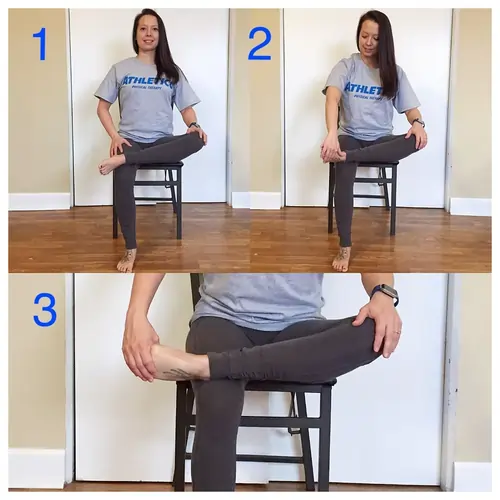
- As in the standing stretch, lower the knee joint toward the floor such that the foot’s toe extends into the ground.
- Then, like the standing stretch but while seated, gently draw the forward while keeping the toe planted in the ground.
- After that, repeat for every foot.
Lying Shin Stretch:
- The patient’s foot is now behind their back while they lie on their side with their knee bent on their upper thigh.
- Grab the forefoot with your back and bring it to the back.
- After that, repeat for every foot.
Stair Stretch:
- The patient is standing with their back to a similar height step, curb, or stool.
- Next, place the top of the foot on the step behind you and lift the leg if you want to stretch.
- To put pressure through the top of the foot on the step until they feel a stretch in the front of their shin, slowly squat down and reduce their body weight through their leg to standing.
- After that, stretch each leg three times.
Standing Stretch:
- The patient is using their left foot to stand.
- Bend the right knee and raise the heel toward the buttocks to extend the right tibialis anterior.
- Next, use the right hand to grasp the top of the right foot.
- Draw your right foot nearer to your buttocks.
- They are pointing their toes toward the ceiling.
- After that, gently draw the foot in until the patient’s right shin feels stretched.
- On each leg, perform this stretching three times.
Tennis Ball Massage:
- The patient stands with the foot resting on an elevated surface in front of you and is comfortably seated with the knee bent.
- Press the tennis ball up against the muscle and use your palm to hold it there.
- Move the tennis ball slowly up and down the tibialis anterior muscle for 30 to 60 seconds while maintaining firm pressure.
- Although the patient finds this exercise painful, it is beneficial to them.
- On the opposite side, repeat this practice.
Band foot drop:
- Near the floor, the patient is gripping a resistance band around an anchor.
- Hold the ankle at the top for a moment after flexing it up toward the torso.
- Next, Return to the starting position gradually.
- Do this exercise ten to fifteen times.
- Then repeat with the opposite side.
Seated toe raise:
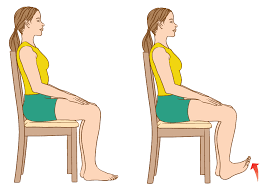
- The patient is Putting your feet in front of you while seated in a chair
- Lift your toes slowly off the ground.
- Three sets of ten to fifteen repetitions of this stretch.
Wall to raise:
- Lift your toes off the ground, keep them there for one or two seconds, and then bring them back down.
- three sets of ten to twenty repetitions of this stretching exercise.
Heel walk:
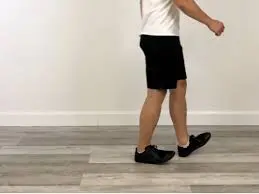
- The patient is Without shoes, place both feet hip-width apart and lift them off the ground until the heels touch the floor.
- The patient is Leaning back and putting your weight on your heels, moving forward.
- Do this exercise again for 30 to 45 seconds.
- Three repetitions of this workout.
Tibialis Anterior press & flex:
- Apply pressure with a massage ball or roller stick to the muscle’s trigger points.
- As you apply pressure, flex your ankles up and down.
- Use the other leg to perform this exercise again.
Strengthening exercise for the tibialis anterior muscle:
- The patient is seated on a bench or the floor.
- Next, Loop an exercise band around the top of the foot after fastening it to a strong object.
- Flex the ankle toward the count of two with the toes facing up.
- Bring the ankle joint back down to four.
- Perform two to three sets of ten to twenty repetitions each day.
- Seated Elastic Band Exercise for Foot Drop.
- Cuff Weight Exercise for Foot Drop.
- Isometric Exercise for Foot Drop.
Seated Elastic Band Exercise for Foot Drop:
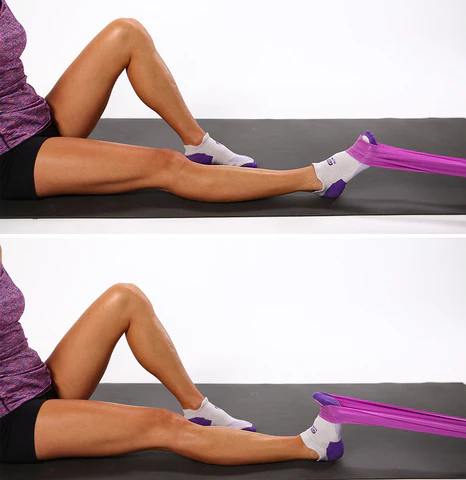
- The patient is Place your leg out in front of you while sitting on the floor.
- The alternative is for the patient to prop their foot up on another chair as they sit in a chair.
- Fasten the band with a loop.
- When they flex the foot up, just the ankle joint moves.
- For one or two seconds, the patient is kept in the end position.
- Next, Return to the starting position slowly.
- Do 10 to 15 repetitions of this workout.
- The ankle joint is flexed up till the anterior tibialis muscle tries and fails.
Cuff Weight Exercise for Foot Drop:
- Start this exercise by flexing your ankle joint such that your foot and toes go up towards your knee joint while you sit with the cuff weight on your foot.
- when the foot is bent upward and maintained for a few seconds.
- Next, Return to the beginning posture by slowly lowering the toes.
- Do this exercise ten to fifteen times.
Isometric Exercise for Foot Drop:
- To begin exercising, place the foot over the ankle joint.
- It is important to ensure that the ankle joint does not move.
- After five seconds of holding this position, carefully release it.
- Do this workout two to three times a day for 10 to 15 repetitions.
FAQs:
The tibialis anterior is used in which sports?
For athletes who participate in activities that include running and jumping, it is especially crucial since it helps stabilize the ankle and foot.
What causes soreness in the tibialis anterior?
Tendonitis of the anterior tibialis
This disorder develops when a traumatic ankle injury or excessive use inflames the tendon. The tendon is extremely tough to treat and may rupture if treatment is not received. Some individuals may have weak muscles, which might result in a “foot drop.”
Why does a tight tibialis anterior occur?
Weakened or incorrectly stimulated lower leg muscles might also result in tibialis anterior pain. The load might be too much when it has to replace another muscle. Additionally, you cannot clear the ground during a stride if trigger points constrict the tibialis anterior.
Is the tibialis anterior worked during squats?
During squatting, additional ankle muscles, including the tibialis anterior and posterior and the peroneus brevis and longus, are also engaged to regulate the foot’s posture.
What is the duration of anterior tibialis pain?
Rest, ice, and over-the-counter drugs are usually sufficient to treat anterior tibial tendinitis in two to four weeks. On the other hand, physical therapy may be necessary for persistent anterior tibial tendinitis. Anterior tibial tendinitis can be treated with mobility exercises and stretching.
What causes the nighttime pain in my tibialis anterior?
The tibialis anterior tendon may experience deterioration and soreness along its entire length with time. When the ankle and foot are at rest with the toes pointed down, this pain is frequently experienced at night. As a result, the tendon is stretched and may develop tendinitis.
Without the tibialis anterior, is it possible to walk?
This muscle aids in regulating the foot’s up-and-down motion. Walking on the heels is made difficult or impossible by weakness in the tibialis anterior muscle, although it often does not severely affect normal walking.
How can tibial pain be resolved?
For three days, or until the pain subsides, use ice multiple times daily. Perform stretches, paying particular attention to the front portion of the shin. To reduce swelling and pain, take aspirin, ibuprofen, or naproxen. Be aware that some medications have adverse effects, including the potential for bleeding and ulceration.
Is it necessary to massage the tibialis anterior?
Ankle and big toe pain might be caused by active trigger points in this muscle. Runners and indoor sportsmen are especially impacted. However, you can use a self-massage to relieve the pain and these places.
What is causing the tightness in my tibialis anterior muscle?
Walking or applying pressure to the affected area are two possible ways to do this. The pain would be worse when you were walking and dropping your foot to the ground right after a heel strike.
How is pain in the anterior tibialis treated?
It could be advised to use anti-inflammatory medications like naproxen (Aleve) or ibuprofen (Motrin or Advil). Take these as prescribed by your physician. Acetaminophen and other mild pain relievers may be utilized.
References
- Ladva, V. (2024b, December 11). Tibialis Anterior Muscle Pain: Cause, symptoms, Treatment and Exercise. Samarpan Physiotherapy Clinic. https://samarpanphysioclinic.com/tibialis-anterior-muscle-pain/
- Sankhla, D. (2022, December 15). Tibialis Anterior Tendonitis Cause, Symptoms, Treatment, Exercise. Samarpan Physiotherapy Clinic. https://samarpanphysioclinic.com/tibialis-anterior-tendonitis/

